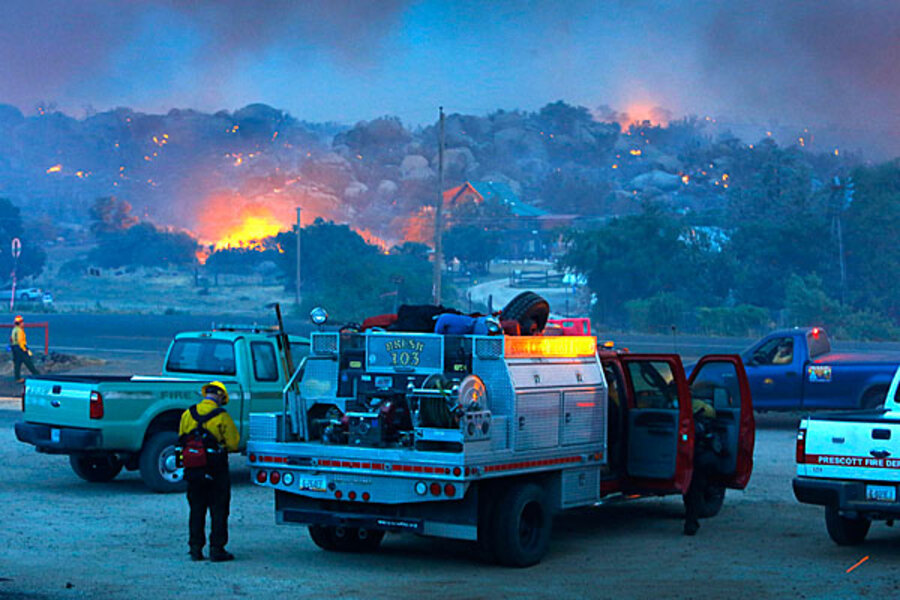19 firefighters killed battling Arizona wildfire, worst toll since 9/11
Loading...
| Yarnell, Ariz.
An elite crew of firefighters trained to battle the nation's fiercest wildfires was overtaken by an out-of-control blaze in Arizona, killing 19 members as they tried to protect themselves from the flames under fire-resistant shields.
It was the most firefighters killed battling a wildfire in the U.S. in decades.
The lightning-sparked fire, which spread to at least 2,000 acres (800 hectares) amid triple-digit temperatures, also destroyed 200 homes and sent hundreds fleeing from Yarnell, a town of about 700 residents about 85 miles (135 kilometers) northwest of Phoenix. Residents huddled in shelters and bars, watching their homes burn on TV as flames lit up the night sky in the forest above the town.
The disaster Sunday afternoon all but wiped out the 20-member Hotshot fire crew based in nearby Prescott, leaving the city's fire department reeling.
"We grieve for the family. We grieve for the department. We grieve for the city," Prescott Fire Chief Dan Fraijo said at a news conference Sunday evening. "We're devastated. We just lost 19 of the finest people you'll ever meet."
The National Fire Protection Association website lists the last wildland fire to kill more firefighters as the 1933 Griffith Park fire of Los Angeles, which killed 29. The most firefighters — 340 — were killed in the 9/11 terrorist attacks in New York, according to the website.
Most people had evacuated from the town, and no injuries or other deaths were reported.
Hotshot crews go through specialized training and are often deployed soon after a fire breaks out. Sometimes they hike for miles into the wilderness with chain saws and backpacks filled with heavy gear to build lines of protection between people and fires. They remove brush, trees and anything that might burn in the direction of homes and cities. This crew had worked other wildfires in recent weeks in New Mexico and Arizona.
As a last-ditch effort at survival, Hotshot crew members are trained to dig into the ground and cover themselves with the tent-like shelter made of fire-resistant material, Fraijo said. The hope in that desperate situation is that the fire will burn over them and they will survive.
"It's an extreme measure that's taken under the absolute worst conditions," Fraijo said.
Nineteen fire shelters were deployed, and some of the firefighters were found inside them, while others were outside the shelters, Mike Reichling, Arizona State Forestry Division spokesman, told the Arizona Republic.
Prescott, which is more than 30 miles (50 kilometers) northeast of Yarnell, is home to one of 110 Hotshot crews in the United States, according to the U.S. Forest Service website. The unit was established in 2002, and the city also has 75 suppression team members.
In 1994, the Storm King Fire near Glenwood Springs, Colorado, killed 14 firefighters who were overtaken by a sudden explosion of flames.
President Barack Obama called the 19 firefighters heroes and said in a statement that the federal government was assisting state and local officials.
"This is as dark a day as I can remember," Gov. Jan Brewer said in a statement. "It may be days or longer before an investigation reveals how this tragedy occurred, but the essence we already know in our hearts: fighting fires is dangerous work."
Brewer said she would travel to the area on Monday.
As the blaze spread, people started fleeing, including Chuck Overmyer and his wife, Ninabill. They were helping friends leave when the blaze switched directions and moved toward his property. They loaded up what belongings they could, including three dogs and a 1930 model hot rod on a trailer.
As he looked out his rear view mirror he could see embers on the roof of his garage.
"We knew it was gone," he said.
He later gathered at the Arrowhead Bar and Grill in nearby Congress along with locals and watched on TV as he saw the fire destroy his house.
Two hundred firefighters were working on the fire Sunday, and several hundred more were expected to arrive Monday.
The fire has forced the closure of parts of state Route 89. Fire crews had no containment late Sunday.
The Red Cross has opened two shelters in the area — at Yavapai College in Prescott and at the Wickenburg High School gym.
____
Billeaud reported from Phoenix. Associated Press writer Brian Skoloff in Yarnell, Arizona, and Associated Press reporter Martin Di Caro in Washington, D.C., also contributed to this story.
Copyright 2013 The Associated Press.







